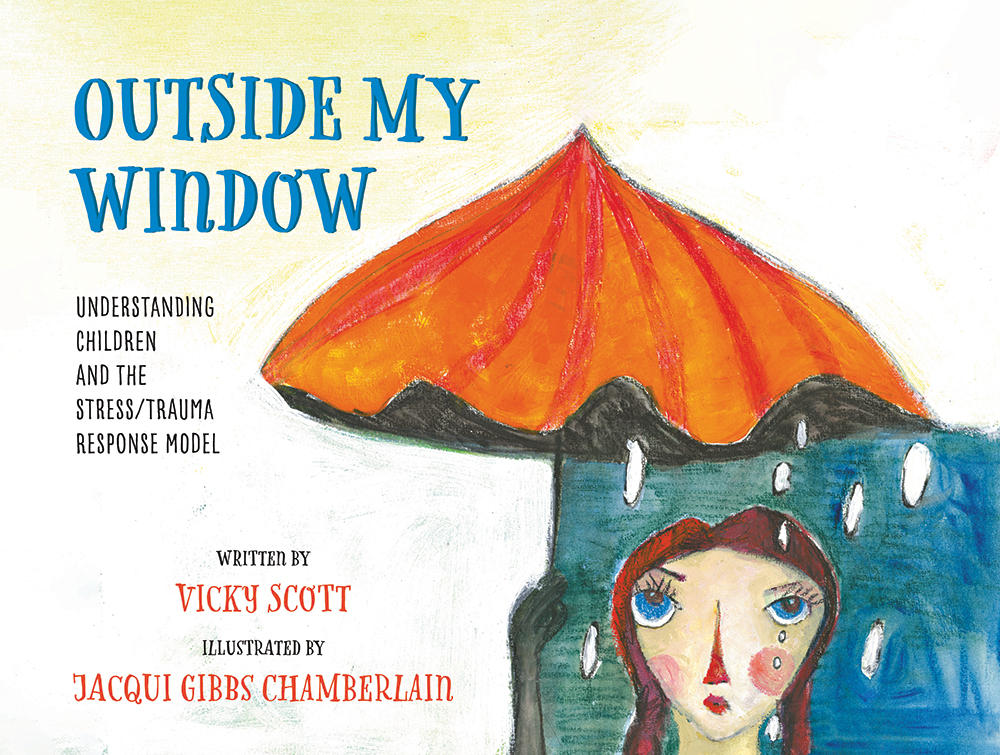Vicky has begun writing therapeutic books to support working with traumatized children, youth and adults with the hope they can be used for therapists, teachers, parents and carers to help understand and work with trauma in a way that is non-judgmental and strength-focused. ‘Outside My Window: Understanding Children and the stress/trauma response model has been reviewed by Book Life and received an A rating. Feedback has also been encouraging.
Outside My Window:
Introduction
Children who experience adverse life experiences (trauma) are often judged by their behaviour or may be labelled with diagnoses. They are often in survival mode because of their traumatic experiences. Outside My Window: helps readers to understand what happens in survival mode, or as one little person said, ‘I am not bad … just sad and mad’.
The purpose of ‘Outside My Window: Understanding children and the stress/trauma response model’ is to teach young children (primarily aged 5–12), and child parts, as well as their carers, teachers and therapists about the impact of Adverse Childhood Experiences (ACEs) on their feelings, body, behaviour, and thoughts about themselves. Many teenagers and adults have also responded to this book due to their past childhood traumas.
Educating parents, teachers, caregivers, and those who work with children, youth and traumatised adults about the ‘Stress Model’ allows for therapeutic, compassionate and helpful conversations that remove blame and shame. There is less judgement, more cooperation, and greater safety for a child who is ‘Outside My Window.’
You can look inside the book and it is now available on Amazon and Facebook (Outside My Window).
Book Review

Using a window as an extended metaphor for the Window of Tolerance, a stress trauma response model, psychologist Scott explains to both children and caregivers the cognitive processes that happen when prolonged stress and trauma is endured, both validating the child while also providing suggestions for how to bring a child back inside their window. Paired with Chamberlain’s expressive and at times, abstract pastel illustrations, Outside My Window has been crafted to make a heavy and complicated topic approachable for young readers, especially with the use of rhyming text.
Achieving its lofty goals— meeting kids on their level and validating them, explaining trauma theory to caregivers, validating traumatized adults who have a “hurt child part inside”—means Outside My Window is a complex, explanatory read delving into difficult subjects with welcome clarity and inviting frankness. The authors note that it’s crafted to inspire “therapeutic, compassionate and helpful” conversations between children and adults, and the child narrator’s generalized account of fight or flight responses and what it means to have “Three brains /all in my head” will naturally inspire questions and comment, as will the at-times unsettling art. (Those three brains, mammal and reptile and human, inspire a fascinating three-way Janus image that will intrigue young readers.) Small graphs of the trauma response model accompany occasional pages, in the corner, separate from the illustrations, with fuller explanations, included in the backmatter.
Ideally read with a grown-up, Outside My Window is a safe and useful book and tool that illuminates, in relatable language, the impact of Adverse Childhood Experiences and the tricky subject of how to recognize, understand, and live with their survival responses. Perhaps best suited for clinical practices, school counsellors or teachers, Outside My Window will serve as a resource for traumatized children and the adults in their lives who care for them.
Takeaway: This picture book introduction to stress and trauma responses will inspire therapeutic discussion.
Great for fans of: Susan Farber Strauss’s Healing Days, Chandra Ghosh Ippen’s Once I Was Very Very Scared.
Production grades
Cover: A-
Design and typography: A
Illustrations: A
Editing: A
Marketing copy: A-
Print Date: 11/21/2022
Feedback
“I work with children who predominately live in group homes, are transitioning into home-for-life placements or are in home-for-life placements. So, much of my therapeutic work focuses on attachment, trauma and dissociation. Your book has been an invaluable resource for both home-for-life parents and children, and I use it at the second session with all families I work with. Home-for-life parents always feedback on how much it puts things into context, while children adopt the language, and it has been useful for creating a shared dialect between children and their home-for-life or foster parents.
One particular client I work with, in a group home, experiences periods of select mutism and frequently dissociates. I read the book with the client over two sessions as they really engaged with the book and asked for a page to be photocopied as they wanted it for their room. In one session, the client arrived and was mute for the majority of the session, where they can communicate with me only by holding up their fingers. In the following session, I asked what was happening for them while they couldn’t speak (at this stage, the selective mutism wasn’t known but rather suspected, and the care parents in the group home were seeing it as defiance); the client said that they were stuck in their lizard brain and couldn’t talk.
So, I wanted to thank you for the book; it has become such an invaluable tool and the one therapeutic resource I use most consistently”.
RM (Reg Psychologist).
“Kia ora Vicky
I work as Primary Mental Health & Addictions Coordinator for Hauora Hokianga & want to purchase 2 more copies of “Outside my Window” which is a brilliant book for counsellors & traumatised people to read.
The first 3 copies I bought some time ago have all gone to children & adults / whanau who needed them so I need some more…
K. J (Primary Mental Health & Addictions Coordinator / Clinician)

